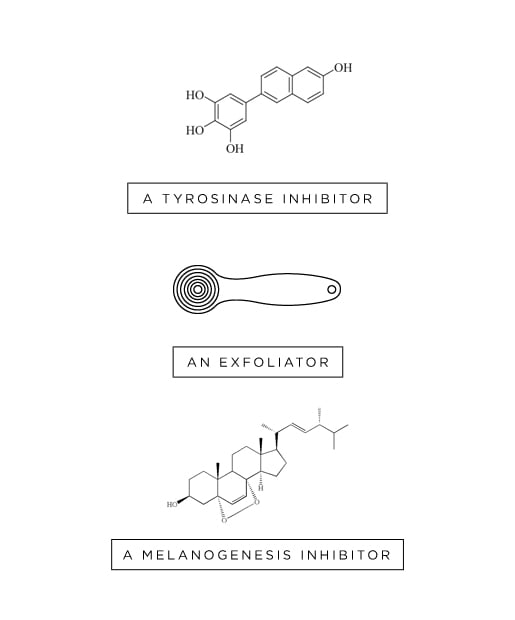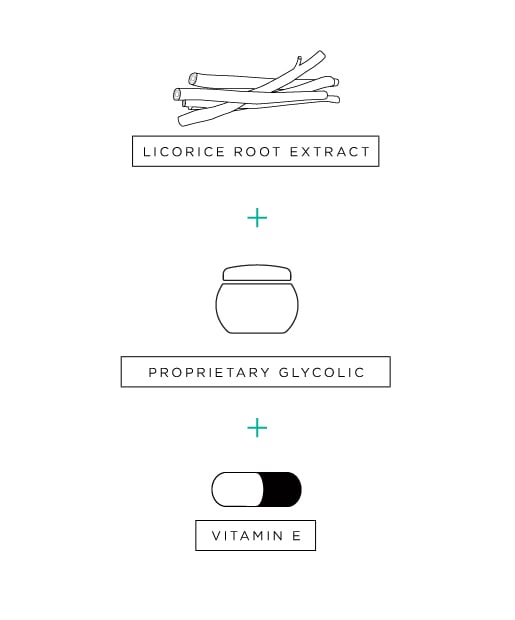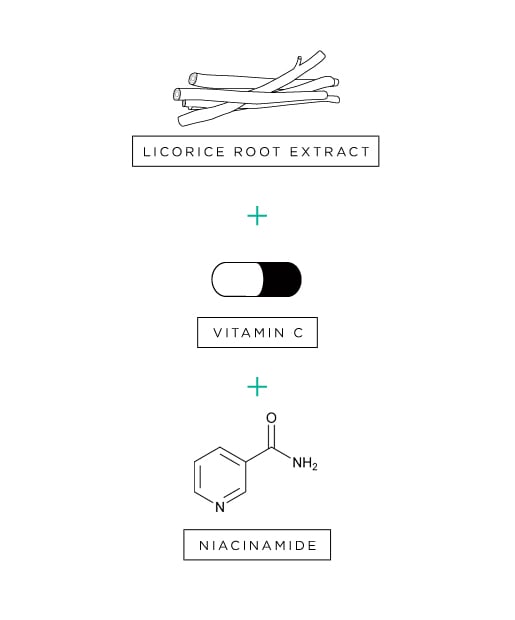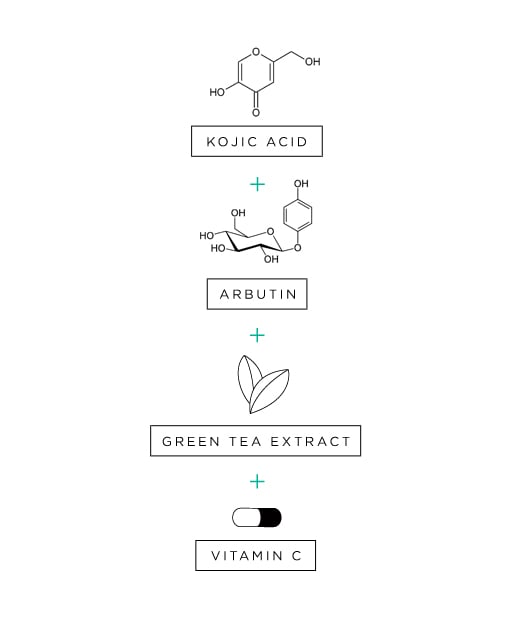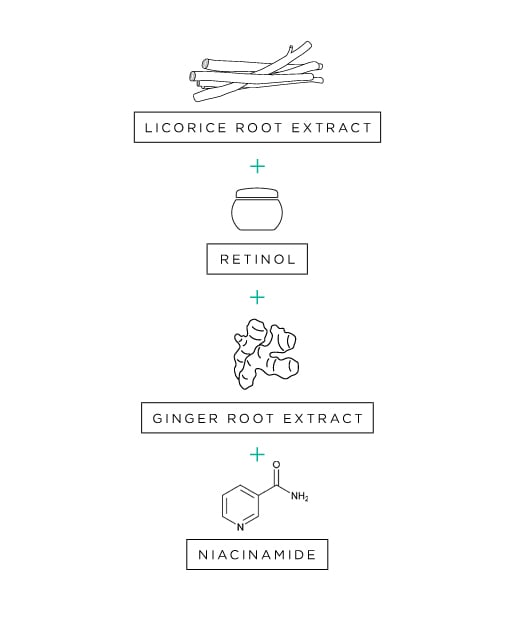According to Woolery-Lloyd, combination therapies are more effective because they attack melanosomes from a variety of angles. To give melanosomes that one-two-three punch, a successful combination therapy product typically contains:
1. A tyrosinase inhibitor (like hydroquinone) that suppresses the enzyme tyrosinase and keeps it from turning tyrosine into melanin.
2. An exfoliator that increases cell turnover to reveal newer, and thus more lightly pigmented, skin. Examples include retinol, glycolic acid and salicylic acid.
3. A melanogenesis inhibitor that stops melanosomes from transferring newly produced melanin to other skin cells in the body.
Woolery-Lloyd notes that some combination therapies also contain penetration enhancers such as kojic acid, which help topical treatments penetrate more deeply into skin. Combining this three-part formula with botanical ingredients and penetration enhancers is a more recent approach to targeting hyperpigmentation.
1. A tyrosinase inhibitor (like hydroquinone) that suppresses the enzyme tyrosinase and keeps it from turning tyrosine into melanin.
2. An exfoliator that increases cell turnover to reveal newer, and thus more lightly pigmented, skin. Examples include retinol, glycolic acid and salicylic acid.
3. A melanogenesis inhibitor that stops melanosomes from transferring newly produced melanin to other skin cells in the body.
Woolery-Lloyd notes that some combination therapies also contain penetration enhancers such as kojic acid, which help topical treatments penetrate more deeply into skin. Combining this three-part formula with botanical ingredients and penetration enhancers is a more recent approach to targeting hyperpigmentation.
Best for: uneven skin tone and dark spots
Licorice: The extract from licorice root is naturally high in glabridin, a chemical compound that inhibits tyrosinase, the enzyme that kick-starts the discoloration process.
Glycolic acid: This chemical exfoliator removes the outer layer of dead skin cells, bringing fresh, new skin to the surface. Most over-the-counter skin care treatments usually have six to 10 percent glycolic acid. Chemical peels, which should be applied by professionals, have concentrations ranging from 20 to 70 percent.
Vitamin E: An antioxidant well known for its soothing properties, vitamin E protects against the sun's damaging rays while moisturizing and healing skin cells.
Licorice: The extract from licorice root is naturally high in glabridin, a chemical compound that inhibits tyrosinase, the enzyme that kick-starts the discoloration process.
Glycolic acid: This chemical exfoliator removes the outer layer of dead skin cells, bringing fresh, new skin to the surface. Most over-the-counter skin care treatments usually have six to 10 percent glycolic acid. Chemical peels, which should be applied by professionals, have concentrations ranging from 20 to 70 percent.
Vitamin E: An antioxidant well known for its soothing properties, vitamin E protects against the sun's damaging rays while moisturizing and healing skin cells.
Best for: sensitive skin and sun damage
Licorice: This tyrosinase inhibitor is known for its soothing qualities, making it a good choice for women with sensitive skin.
Vitamin C: This antioxidant combats free radicals that can contribute to hyperpigmentation, such as UV rays, pollution and heat, and stimulates collagen production, which reduces the appearance of scars.
Niacinamide: This ingredient stops melanosomes from transferring melanin to surrounding skin cells while increasing skin's moisture and enhancing its barrier function.
Licorice: This tyrosinase inhibitor is known for its soothing qualities, making it a good choice for women with sensitive skin.
Vitamin C: This antioxidant combats free radicals that can contribute to hyperpigmentation, such as UV rays, pollution and heat, and stimulates collagen production, which reduces the appearance of scars.
Niacinamide: This ingredient stops melanosomes from transferring melanin to surrounding skin cells while increasing skin's moisture and enhancing its barrier function.
Best for: dark spots from acne and oily skin
Kojic acid: It not only suppresses tyrosinase activity, kojic acide also helps topical treatments penetrate more deeply into the skin.
Arbutin: Extracted from the bearberry plant, arbutin is a natural alternative to hydroquinone. It curbs melanocyte activity and helps break down extra melanin in the skin.
Green tea: This natural, soothing antioxidant blocks free radicals.
Vitamin C: Also referred to as ascorbic acid, this antioxidant not only inhibits tyrosinase, it also treats oily skin by blocking pore-clogging debris.
Kojic acid: It not only suppresses tyrosinase activity, kojic acide also helps topical treatments penetrate more deeply into the skin.
Arbutin: Extracted from the bearberry plant, arbutin is a natural alternative to hydroquinone. It curbs melanocyte activity and helps break down extra melanin in the skin.
Green tea: This natural, soothing antioxidant blocks free radicals.
Vitamin C: Also referred to as ascorbic acid, this antioxidant not only inhibits tyrosinase, it also treats oily skin by blocking pore-clogging debris.
Best for: acne scars
Licorice: The extract from licorice root is naturally high in glabridin, a chemical compound that inhibits tyrosinase.
Retinol: This vitamin A derivative encourages old skin cells to shed and uncovers new cells.
Ginger root extract: This antioxidant works as an anti-inflammatory to protect skin from harsher topical skin care products. It is also used to stimulate melanocyte activity in skin cells, evening out patches of skin that are too lightly pigmented.
Niacinamide: This ingredient inhibits melanosome transfer to surrounding skin cells while increasing skin's moisture and enhancing the barrier function of skin.
Licorice: The extract from licorice root is naturally high in glabridin, a chemical compound that inhibits tyrosinase.
Retinol: This vitamin A derivative encourages old skin cells to shed and uncovers new cells.
Ginger root extract: This antioxidant works as an anti-inflammatory to protect skin from harsher topical skin care products. It is also used to stimulate melanocyte activity in skin cells, evening out patches of skin that are too lightly pigmented.
Niacinamide: This ingredient inhibits melanosome transfer to surrounding skin cells while increasing skin's moisture and enhancing the barrier function of skin.



